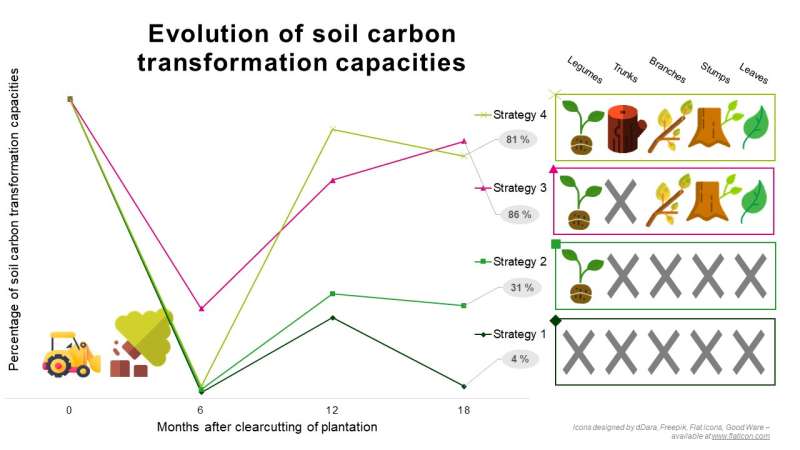Rubber production: How can soil health be restored after clear-cutting a 40-year-old plantation?

Returning the biomass from logging to the soil and planting legume cover crops enable rapid restoration of the main soil functions, just 18 months after clear-cutting of an aging rubber plantation. A team of scientists has demonstrated this in two sites in Côte d'Ivoire since 2017. While pressure on land and the fight against deforestation mean producers are obliged to continuously replant on the same plots, this finding shows that agroecological practices can increase the sustainability of rubber plantations.
These findings, which are important for rubber planters, were published in November in Science of the Total Environment. The discovery was made by a group of scientists and plantation companies including CIRAD, IRD and the Universities of Clermont Auvergne (France) and Nangui Abrogoua (Abidjan, Côte d'Ivoire), as well as the Société Africaine de Plantations d'Hévéas (African rubber plantation company, SAPH-SIPH group) and the Société des Caoutchoucs de Grand Béréby (Grand Béréby rubber company, SOGB-SOCFIN group).
Côte d'Ivoire is the world's fourth largest producer of natural rubber. With a million tons annually, the country provides 80% of all African production. An important agricultural sector, rubber is grown over a cycle of 25 to 40 years, before clear-cutting and replanting ready for a new cycle.
"To preserve the forests, rubber planters have no choice but to repeatedly plant on the same plots of land. The clear-cutting of aging plots in industrial plantations is done using a bulldozer, a harmful method for soil structure and health," says Thibaut Perron, an agronomist at CIRAD and lead author of the study. "For a long time, the practice consisted in burning logging residues, in other words trunks, branches and stumps, before planting the following cycle. This was justified in particular by concerns about the propagation of fomes, a disease that affects the roots of rubber trees. With the voluntary phase-out of slash-and-burn systems and concerns about sustainable soil management, planters have committed to agroecological practices that enable the restoration of soils disturbed by clear-cutting."
Full restoration of certain soil functions thanks to logging residues and a legume
In the two sites studied, four strategies were tested after clear-cutting of aging plantations:
- No return of logging residues and no legumes planted
- 2.No return of logging residues and a legume planted just after clear-cutting
- Return of logging residues, except trunks, and a legume planted
- Full return of logging residues, and a legume planted.
Using Biofunctool, a tool developed by IRD and CIRAD, for 18 months after clear-cutting the researchers analyzed three of the main soil functions: carbon dynamics, nutrient cycling, and structure maintenance in the surface horizon. Their findings show that 18 months after clear-cutting, the first strategy does not result in any restoration of soil functions. The second strategy ensures partial restoration, while the third and fourth strategies, which return logging residues, enable full restoration of some functions.
Alain Brauman, a soil ecologist at IRD, co-author of the publication and co-developer of Biofunctool, adds:"Returning logging residues and planting a legume increase both the biodiversity of soil organisms (bacteria, nematodes, earthworms, etc.) and soil health. Our measurements also show that there is a strong correlation between the diversity of soil macrofauna and soil functions (or health) at the two sites studied."
Contributing to the agroecological transition in rubber plantations
Returning logging residues is an agroecological solution. It helps to stimulate the ecological processes at work in soil mineral cycles. Nitrogen, phosphorus and potassium are all essential to plant growth. The results of the project also show that this practice helps to increase the stabilization of soil carbon, and thereby contributes to reducing the carbon footprint of rubber production.
However, there are other possible uses of logging residues. Since the return of trunks has not shown any impact on soil health 18 months after clear-cutting, the scientists are exploring the possible compromises between the restoration of soil fertility and the use of wood outside plantations."The trunks take longer to break down, so it is possible that their effect on soil restoration will be seen at a later point," says Thibault Perron."However, the use of trunks can also be a useful avenue to help to meet the growing demand for wood and biomass energy in the cities of the country."
Finally, the team is simultaneously studying tree growth according to the four "unfertilised" strategies, by comparing them with other similar fertilized plots. The goal is to determine whether the return of residues can ensure good tree growth while reducing the use of chemical fertilizers. Thibaut Perron explains: "The trees are now three years old. Our data currently show better growth of fertilized trees, but the trees with residues are catching up in certain situations. If we can show that residue management can reduce mineral fertilization, this will be an important step for producers in terms of optimizing the costs and the environmental sustainability of plantations."
More information: Thibaut Perron et al, Logging residues promote rapid restoration of soil health after clear-cutting of rubber plantations at two sites with contrasting soils in Africa, Science of The Total Environment (2021). DOI: 10.1016/j.scitotenv.2021.151526
Journal information: Science of the Total Environment
Provided by Institut de Recherche pour le Développement (IRD)



















